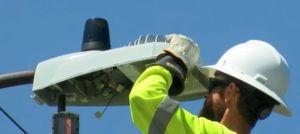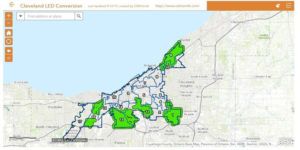As part of its smart city initiative and to better serve its nearly 400,000 residents, the City of Cleveland in Ohio has deployed a networked streetlight control system that is also integrated with the Police Department’s street monitoring video cameras.
Cleveland has adopted the T-Light Galaxy Network from Telematics Wireless, a subsidiary of Singapore-based technology group ST Engineering (STE), to manage the city’s 61,000 streetlights. The project combines the conversion of all streetlights in the city to LED luminaires with the STE Telematics Wireless networked lighting control system and 1,000 cameras that are operated by the Cleveland Police Department. Cleveland Public Power (CPP), a city-owned utility, deployed the T-Light Galaxy communications infrastructure in just three business days, using FCC licensed frequencies to ensure the system is both secure and reliable. Based in Texas, the system provider, STE Telematics Wireless, is a leader in smart city wireless networks and applications.
 Smart lighting controls can reduce annual operating costs by as much as 20% in addition to the anticipated 50% cost savings from converting to LED streetlights. In the Cleveland installation, the T-Light Galaxy platform functions as a wide-area communications network. The end-to-end system provides a web-accessed application software, BrightCity, with 61,000 individual Galaxy LCU (Light Control Unit) networked lighting controllers for each streetlight’s operation. Using the STE Telematics Wireless Bright City CMS (Control and Management Software) platform, the system enables Cleveland to set different light intensity for residential, commercial and industrial locations, pre-program schedules for routine and real-time management of special conditions, and proactively manage maintenance support.
Smart lighting controls can reduce annual operating costs by as much as 20% in addition to the anticipated 50% cost savings from converting to LED streetlights. In the Cleveland installation, the T-Light Galaxy platform functions as a wide-area communications network. The end-to-end system provides a web-accessed application software, BrightCity, with 61,000 individual Galaxy LCU (Light Control Unit) networked lighting controllers for each streetlight’s operation. Using the STE Telematics Wireless Bright City CMS (Control and Management Software) platform, the system enables Cleveland to set different light intensity for residential, commercial and industrial locations, pre-program schedules for routine and real-time management of special conditions, and proactively manage maintenance support.
For the Cleveland project, STE Telematics Wireless installed three T-Light Galaxy Base Station gateways to cover the entire city’s network of streetlights, and a fourth gateway is planned for city-wide redundant coverage. Backhaul communication between the Base Station and the BrightCity CMS platform is based on Ethernet/Fiber, with Wireless APN used as a backup backhaul communication infrastructure in case of Fiber network failure. The project will not only improve the quality of light throughout the city, but will also help lower its carbon footprint, while providing improved and safety for citizens. The city plans to test other smart devices that run on the company’s Galaxy Network soon.
“This digital transformation of our streetlights fulfils a key component of the Safe, Smart CLE Project launched earlier this year,” said Cleveland Public Power’s commissioner, Ivan Henderson. “Not only does the Telematics Wireless system enable us to control and manage our streetlight operations far more efficiently and cost-effectively, it also provides Cleveland with the backbone for more advanced, future-ready Smart City applications like the high-definition images and our police department’s remote control of streetlights that can be dimmed or brightened throughout the city.”
Amir Hirsch, head of business development at STE Telematics Wireless, said, “Cleveland’s adoption and installation of the T-Light Galaxy streetlight control system is ultimately part of a bold statement from one of the country’s premier smart cities. It demonstrates a genuine commitment to visionary leadership, service, sustainability and cost containment for all the city’s citizens.”





